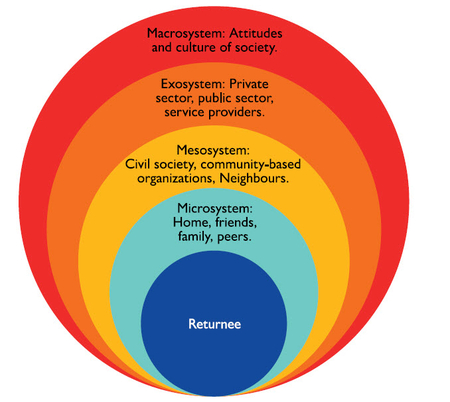This section presents explores the definition of community and provides guidance on fostering a participatory approach for community based projects.
- Definition of a community
- A participatory approach
To design a community project for a specific context, it is crucial to define who the “community” consists of – a task that is not always straightforward. For the purposes of this Handbook we will use the following definition of community, “a number of persons who regularly interact with one another, within a specific geographical territory, and who tend to share common values, beliefs and attitudes.”28 The definition of community is context-specific and depends on cultural, social, political and economic conditions as well as local migration trends.
One way to define a community is by using the ecosystem approach.29 This approach recognizes that each returnee exists within a system of actors that interact with each other and may be supporting or hindering the returnee’s reintegration.
To identify a returnee’s community, qualitative research, such as in-person interviews or focus groups, can be used to understand which institutions, organizations or individuals are considered to be influential members of a specific geographic area. Once those actors are identified, key informants (such as religious leaders, local authorities, heads of community-based organizations, prominent elders or others) can be brought in for focus group discussions about the impact of return and reintegration on the community and possible community-level assistance as they see it.
Figure 3.1: Understanding a returnee’s ecosystem

Community assessment and engagement should always occur using a participatory approach, which means that returnees, families or communities of return are consulted. Participation (personal involvement in assessment and decision-making around reintegration) can increase the sense of empowerment, self-reliance and ownership over projects. This approach acknowledges that those engaged in reintegration projects are knowledgeable about local developmental and environmental needs and have unique insight into how to make reintegration more sustainable.
Carrying out focus group discussions with an array of key informants when assessing communities, as well as when deciding on reintegration projects, makes the process a collaborative one. During these focus group discussions, the process and aims of reintegration projects need to be clearly explained and any questions addressed so that expectations are managed.
Inclusivity and conflict sensitivity in participatory engagement
When engaging the community, it is important to be aware of existing conflict issues and marginalization of specific groups. Otherwise, the process could exacerbate these problems by excluding those groups already marginalized or by reinforcing negative power dynamics. For this reason, it is important to strive for inclusivity of different perspectives in assessment and engagement processes.
Making participatory approaches inclusive
➔ Ask: Who needs to be included in the process? Who has something positive to contribute? Who could create challenges?
➔ Identify: All relevant stakeholders, along with potential barriers or challenges to their participation.
➔ Interview: Key informants directly by seeking them out.
➔ Recognize: Power imbalances among stakeholders. Who may have less power? Women? Children and youth? People with disabilities? Those with less education? Create extra opportunity for participation for these groups.
➔ Hold: Focus groups and forums at times and in places especially convenient for the least vocal participants, or offer separate or private meetings if appropriate.
➔ Create: Opportunity for people to lend their voice and perspective anonymously, or in spaces that foster trust and openness.
28 IOM Handbook on Protection and Assistance for Migrants Vulnerable to Violence, Exploitation and Abuse (forthcoming).
29 More information on the ecosystem approach in reintegration settings can be found in Setting Standards for an Integrated Approach to Reintegration, (Samuel Hall/IOM, 2017) commissioned by IOM and funded by DFID.
- 3.1/3.5
- Next